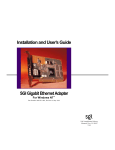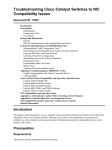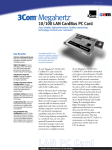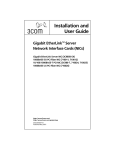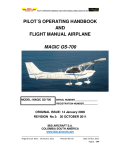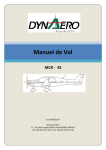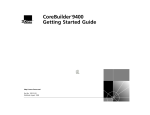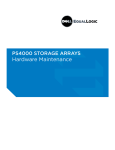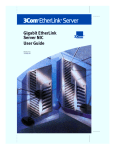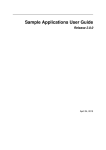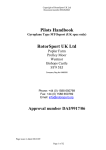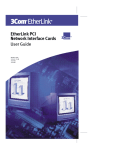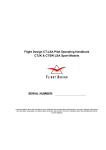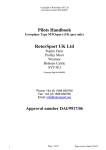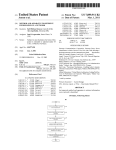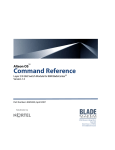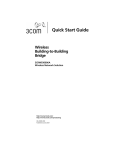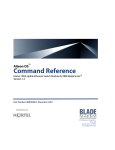Download Installation and User Guide
Transcript
Installation and
User Guide
Gigabit EtherLink™ Server
Network Interface Cards (NICs) for
Windows 2000 and Windows NT 4.0
Gigabit EtherLink Server NIC (3C985B-SX)
1000BASE-SX PCI Fiber NIC (710011, 710012)
10/100/1000BASE-T PCI NIC (3C986-T, 710024, 710025)
1000BASE-LX PCI Fiber NIC (710026)
http://www.3com.com/
http://www.3com.com/productreg
Published May 2001
User Guide version 2.1
3Com Corporation
■
5400 Bayfront Plaza
■
Santa Clara, California
■
95052-8145
Copyright © 2001 3Com Corporation. All rights reserved. No part of this documentation may be reproduced in any form or by any means or
used to make any derivative work (such as translation, transformation, or adaptation) without written permission from 3Com Corporation.
3Com Corporation reserves the right to revise this documentation and to make changes in content from time to time without obligation on the
part of 3Com Corporation to provide notification of such revision or change.
3Com Corporation provides this documentation without warranty, term, or condition of any kind, either implied or expressed, including, but
not limited to, the implied warranties, terms or conditions of merchantability, satisfactory quality, and fitness for a particular purpose. 3Com
may make improvements or changes in the product(s) and/or the program(s) described in this documentation at any time.
If there is any software on removable media described in this documentation, it is furnished under a license agreement included with the
product as a separate document, in the hard copy documentation, or on the removable media in a directory file named LICENSE.TXT or
!LICENSE.TXT. If you are unable to locate a copy, please contact 3Com and a copy will be provided to you.
UNITED STATES GOVERNMENT LEGEND
If you are a United States government agency, then this documentation and the software described herein are provided to you subject to the following:
All technical data and computer software are commercial in nature and developed solely at private expense. Software is delivered as
“Commercial Computer Software” as defined in DFARS 252.227-7014 (June 1995) or as a “commercial item” as defined in FAR 2.101(a) and
as such is provided with only such rights as are provided in 3Com’s standard commercial license for the Software. Technical data is provided
with limited rights only as provided in DFAR 252.227-7015 (Nov 1995) or FAR 52.227-14 (June 1987), whichever is applicable. You agree not to
remove or deface any portion of any legend provided on any licensed program or documentation contained in, or delivered to you in
conjunction with, this User Guide.
Unless otherwise indicated, 3Com registered trademarks are registered in the United States and may or may not be registered in other countries.
3Com is a registered trademark and the 3Com logo and Dynamic Access are trademarks of 3Com Corporation. 3Com Facts is a service mark of
3Com Corporation.
Intel is a registered trademark of Intel Corporation. Novell and NetWare are registered trademarks of Novell, Inc.
Alteon Web Systems, Alteon WebSystems, ACEnic and the A Design Logo are trademarks of Alteon WebSystems, Inc., a wholly owned
subsidiary of Nortel Networks.
All other company and product names may be trademarks of the respective companies with which they are associated.
The software and documentation contained herein are an interim version provided by 3Com Corporation for use with 3Com Gigabit NICs, and
contain ACEnic software earlier released by Alteon WebSystems, Inc. circa Spring 200.
For all Gigabit product questions, contact 3Com Corporation directly at: www.3com.com/promotions/nics/nictransition.html.
Contents
Preface
1
How This Manual Is Organized 1
Operating System Commands 1
Contacting 3Com 1
Online Technical Services 2
World Wide Web Site 2
3Com Knowledgebase Web Services 2
3Com FTP Site 2
3Com Bulletin Board Service 2
Access by Analog Modem 3
Access by Digital Modem 3
3Com Facts Automated Fax Service 3
Support from Your Network Supplier 3
Support from 3Com 4
Returning Products for Repair 6
1
2
About the NIC 7
Features 7
Key Protocols and Interfaces 8
Adaptive Interrupt Frequency 8
Dual DMA Channels 8
32-bit or 64-bit PCI Bus Master 8
ASIC with Embedded RISC Processor
Physical Description 9
1000Base-SX Fiber NICs 9
Connectors 9
LEDs 9
10/100/1000Base-T NICs 10
Connectors 10
LEDs 10
Installing the NIC Hardware
System Requirements 11
Safety Precautions 12
Pre-Installation Checklist 12
NIC Installation 12
Connecting the Network Cables
1000Base-SX NIC 13
10/100/1000Base-T NIC 14
11
13
8
Contents
3
Installing the Driver Software in Windows 2000
Installing the Driver Software 15
Modifying Configuration Parameters 16
Removing the NIC or Moving it to a Different Slot
Removing the Driver Software 17
4
15
17
Installing the Driver Software in Windows NT 4.0
19
Installing the Driver Software 19
Modifying Configuration Parameters 21
Updating the Driver Software 22
Moving the NIC to a Different Slot 22
Removing the Driver Software 23
5
6
A
Installing DynamicAccess Software
25
About DynamicAccess Software 25
Installing DynamicAccess Software in Windows NT 4.0 or Windows 2000
Troubleshooting
27
Hardware Diagnostic Utility 27
DOS Diagnostics Internal/External Loopback Test (MS-DOS)
Checking the Port LEDs 29
1000Base-SX NICs 29
10/100/1000Base-T NIC 30
Troubleshooting Checklist 31
3Com Support Information 31
Specifications
33
1000Base-SX Link Characteristics 33
10/100/1000Base-T Cable Specifications
Performance Specifications 33
Physical Characteristics 34
Power Requirements 34
Environmental Specifications 34
33
Warranty and Software License Agreement
3Com Corporation Limited Warranty
FCC Class B Statement
FCC Declaration of Conformity
3Com End User Software License Agreement
Product Registration
27
25
Preface
This manual describes how to install and use the 3Com Gigabit EtherLink Server network interface cards (NICs) in
a Microsoft Windows 2000 or Windows NT 4.0 operating environment. The procedures in this manual assume
that you are a system or network administrator experienced in installing similar hardware.
How This Manual Is Organized
This manual is organized as follows:
■ Chapter 1, "About the NIC," describes the features of the NICs. This chapter also describes the NIC faceplates
and LED indicators.
■ Chapter 2, "Installing the NIC Hardware," lists the hardware and software requirements for NIC
installation and use, and provides instructions to physically install the NIC in your system.
■ Chapter 3, "Installing the Driver Software in Windows 2000," explains how to install the NIC software
under Windows 2000.
■ Chapter 4, "Installing the Driver Software in Windows NT 4.0," explains how to install the NIC software
under Windows NT 4.0.
■ Chapter 5, "Installing DynamicAccess Software," explains how to install 3Com DynamicAccess software
under Windows. DynamicAccess software adds intelligence to the NIC to improve network performance,
management, and control.
■ Chapter 6, "Troubleshooting," provides a list of items to check for basic installation and configuration
problems.
■ Appendix A, "Specifications," provides NIC hardware specifications.
Operating System Commands
This manual may not include all necessary hardware procedures or software commands. Instead, it may name
specific tasks and refer you to operating system documentation or the hardware handbook that was shipped with
your system.
You might need to use supplemental documentation for the following types of information:
■ Shutting down the system
■ Getting access to the system’s PCI slots
■ Booting the system
■ Configuring devices
■ Other basic software procedures
Contacting 3Com
3Com provides easy access to technical support information through a variety of services. This appendix describes
these services.
Information contained in this appendix is correct at time of publication. For the most recent information, 3Com
recommends that you access the 3Com Corporation World Wide Web site.
1
Preface
Online Technical Services
3Com offers worldwide product support 24 hours a day, 7 days a week, through the following online systems:
■ World Wide Web site
■ 3Com Knowledgebase Web Services
■ 3Com FTP site
■ 3Com Bulletin Board Service (3Com BBS)
■ 3Com FactsSM Automated Fax Service
World Wide Web Site
To access the latest networking information on the 3Com Corporation World Wide Web site enter this URL into
your Internet browser:
http://www.3com.com/
This service provides access to online support information such as technical documentation and a software library,
as well as support options that range from technical education to maintenance and professional services.
3Com Knowledgebase Web Services
This interactive tool contains technical product information compiled by 3Com expert technical engineers around the
globe. Located on the World Wide Web at http://knowledgebase.3com.com, this service gives all 3Com
customers and partners complementary, round-the-clock access to technical information on most 3Com products.
3Com FTP Site
Download drivers, patches, software, and MIBs across the Internet from the 3Com public FTP site. This service is
available 24 hours a day, 7 days a week.
To connect to the 3Com FTP site, enter the following information into your FTP client:
■ Hostname: ftp.3com.com
■ Username: anonymous
■ Password: <your Internet e-mail address>
NOTE: You do not need a user name and password with Web browser software such as Netscape Navigator
and Internet Explorer.
3Com Bulletin Board Service
The 3Com BBS contains patches, software, and drivers for 3Com products. This service is available through analog
modem or digital modem (ISDN) 24 hours a day, 7 days a week.
2
Contacting 3Com
Access by Analog Modem
To reach the service by modem, set your modem to 8 data bits, no parity, and 1 stop bit. Call the telephone
number nearest you:
Country (Region)
Data Rate
Telephone Number
Australia
Up to 14,400 bps
61 2 9955 2073
Brazil
Up to 28,800 bps
55 11 5181 9666
France
Up to 14,400 bps
33 1 6986 6954
Germany
Up to 28,800 bps
4989 62732 188
Hong Kong
Up to 14,400 bps
852 2537 5601
Italy
Up to 14,400 bps
39 2 27300680
Japan
Up to 14,400 bps
81 3 5977 7977
Mexico
Up to 28,800 bps
52 5 520 7835
P.R. of China
Up to 14,400 bps
86 10 684 92351
Taiwan
Up to 14,400 bps
886 2 377 5840
U.K.
Up to 28,800 bps
44 1442 438278
U.S.A.
Up to 53,333 bps
1 847 262 6000
Access by Digital Modem
ISDN users can dial in to the 3Com BBS using a digital modem for fast access up to 64 Kbps. To access the 3Com
BBS using ISDN, call the following number:
1 847 262 6000
3Com Facts Automated Fax Service
The 3Com Facts automated fax service provides technical articles, diagrams, and troubleshooting instructions on
3Com products 24 hours a day, 7 days a week.
Call 3Com Facts using your Touch-Tone telephone:
1 408 727 7021
Support from Your Network Supplier
If you require additional assistance, contact your network supplier. Many suppliers are authorized 3Com service
partners who are qualified to provide a variety of services, including network planning, installation, hardware
maintenance, application training, and support services.
When you contact your network supplier for assistance, have the following information ready:
■ Product model name, part number, and serial number
■ A list of system hardware and software, including revision levels
■ Diagnostic error messages
■ Details about recent configuration changes, if applicable
If you are unable to contact your network supplier, see the following section on how to contact 3Com.
3
Preface
Support from 3Com
If you are unable to obtain assistance from the 3Com online technical resources or from your network supplier,
3Com offers technical telephone support services. To find out more about your support options, please the 3Com
technical telephone support phone number at the location nearest you.
When you contact 3Com for assistance, have the following information ready:
■ Product model name, part number, and serial number
■ A list of system hardware and software, including revision levels
■ Diagnostic error messages
■ Details about recent configuration changes, if applicable
Here is a list of worldwide technical telephone support numbers:
Country (Region)
Asia Pacific Rim
Australia
Hong Kong
India
Indonesia
Japan
Malaysia
New Zealand
Pakistan
Philippines
P.R. of China
Singapore
S. Korea
From anywhere in S. Korea:
From Seoul:
Taiwan
Thailand
Europe
From anywhere in Europe, call:
4
Telephone Number
1 800 678 515
800 933 486
+61 2 9937 5085
001 800 61 009
0031 61 6439
1800 801 777
0800 446 398
+61 2 9937 5085
1235 61 266 2602
10800 61 00137 or
021 6350 1590
800 6161 463
00798 611 2230
(0)2 3455 6455
0080 611 261
001 800 611 2000
+31 (0)30 6029900 phone
+31 (0)30 6029999 fax
Contacting 3Com
Country (Region)
Telephone Number
Europe, South Africa, and Middle East
From the following countries, you may use the toll-free numbers:
Austria
Belgium
Denmark
Finland
France
Germany
Hungary
Ireland
Israel
Italy
Netherlands
Norway
Poland
Portugal
South Africa
Spain
Sweden
Switzerland
U.K.
0800 297468
0800 71429
800 17309
0800 113153
0800 917959
0800 1821502
00800 12813
1800 553117
1800 9453794
1678 79489
0800 0227788
800 11376
00800 3111206
0800 831416
0800 995014
900 983125
020 795482
0800 55 3072
0800 966197
Latin America
Argentina
Brazil
Chile
Colombia
Mexico
Peru
Puerto Rico
Venezuela
AT&T +800 666 5065
0800 13 3266
1230 020 0645
98012 2127
01 800 CARE (01 800 2273)
AT&T +800 666 5065
800 666 5065
AT&T +800 666 5065
North America
1-800-527-8677
5
Preface
Returning Products for Repair
Before you send a product directly to 3Com for repair, you must first obtain an authorization number. Products
sent to 3Com without authorization numbers will be returned to the sender unopened, at the sender’s expense.
To obtain an authorization number, call or fax:
Country (Region)
Telephone Number
Fax Number
Asia, Pacific Rim
+65 543 6500
+65 543 6348
Europe, South Africa, and
Middle East
+31 30 6029900
+31 30 6029999
Latin America
1 408 326 2927
1 408 326 3355
From the following countries, you may call the toll-free numbers; select option 2
and then option 2:
6
Austria
Belgium
Denmark
Finland
France
Germany
Hungary
Ireland
Israel
Italy
Netherlands
Norway
Poland
Portugal
South Africa
Spain
Sweden
Switzerland
U.K.
0800 297468
0800 71429
800 17309
0800 113153
0800 917959
0800 1821502
00800 12813
1800 553117
1800 9453794
1678 79489
0800 0227788
800 11376
00800 3111206
0800 831416
0800 995014
900 983125
020 795482
0800 55 3072
0800 966197
U.S.A. and Canada
1-800-527-8677
1 408 326 7120
1
About the NIC
The 3Com Gigabit EtherLink Server NIC connects your PCI-compliant server to a Gigabit Ethernet network. This guide
covers the following NICs:
■ 3Com Gigabit EtherLink Server fiber NIC
■ 3Com 1000Base-SX fiber NICs (512 KB and 1 MB memory)
■ 3Com 1000Base-LX fiber NIC
■ 3Com 10/100/1000Base-T (3C986-T) copper NICs (512 KB and 1 MB memory)
The 10/100/1000Base-T Gigabit Ethernet NIC is shown below. Each NIC incorporates a technology that transfers
data at a maximum rate of one gigabit per second—10 times the rate of a Fast Ethernet NIC.
Each NIC targets the increased congestion experienced at the backbone and server in today’s networks, while providing a
future upgrade path for high-end workstations that require more bandwidth than Fast Ethernet can provide.
Included with your NIC is the following:
■ Anti-static bag (used for protecting the NIC when stored or shipped). Keep the NIC in its packaging until ready
for installation.
■ CD-ROM with NIC driver software and documentation.
Inform your network supplier of any missing or damaged items. If you need to return the NIC, you must pack it in
the original (or equivalent) packing material or the warranty will be voided.
Features
Following is a list of the Gigabit Ethernet NIC features:
■ Full-duplex Gigabit Ethernet interface (IEEE 802.3-1999)
■ Interoperability with existing Ethernet and Fast Ethernet equipment
7
1
About the NIC
■
■
■
■
■
■
■
■
■
Standard Ethernet frame size (up to 1,518 bytes)
Supports 32 multicast addresses
Adaptive interrupt frequency (maximizes network throughput; adapts to traffic load)
Dual DMA channels
33/66 MHz, 32-bit or 64-bit PCI bus master with adaptive DMA
PCI Local Bus Rev 2.2 compliant: 17.3 cm x 10.7 cm (6.8" x 4.2")
ASIC with on-chip MAC and dual RISC processors
Universal dual voltage signaling (3.3V and 5V)
Status LEDs
Key Protocols and Interfaces
The NIC is interoperable with existing Ethernet equipment assuming standard Ethernet minimum and maximum frame
size (64 to 1518 bytes), frame format, and compliance with the following standards and protocols:
■ Gigabit Ethernet (IEEE 802.3-1999)
■ Logical Link Control (IEEE 802.2)
■ Flow Control (IEEE 802.3x)
Adaptive Interrupt Frequency
The NIC driver intelligently adjusts host interrupt frequency based on traffic conditions, in order to increase overall
application throughput. In light traffic, the NIC driver interrupts the host for each received packet, minimizing
latency. When traffic is heavy, the NIC issues one host interrupt for multiple, back-to-back incoming packets,
preserving host CPU cycles.
Dual DMA Channels
The PCI interface on the NIC contains two independent DMA channels for simultaneous read and
write operations.
32-bit or 64-bit PCI Bus Master
Compliant with PCI Local Bus Rev 2.2, the PCI interface on the NIC is compatible with both 32-bit and 64-bit PCI
buses. As a bus master, the NIC requests access to the PCI bus instead of waiting to be polled.
ASIC with Embedded RISC Processor
The core control for the NIC resides in a tightly integrated, high-performance ASIC. The ASIC includes dual RISC
processors. This provides the flexibility to add new features to the card and adapt it to future network
requirements via software download. This also enables the NIC drivers to exploit the built-in host off-load
functions on the NIC as host operating systems are enhanced to take advantage of these functions.
8
Physical Description
Physical Description
1000Base-SX Fiber NICs
RX
DATA
TX
1000
BASE-SX
The 1000Base-SX NIC faceplate configuration is shown below.
LINK
Connectors
The faceplate of the NIC has one 1000Base-SX fiber-optic connector for connecting the NIC to a Gigabit
Ethernet segment.
LEDs
There are two LEDs on the faceplate: one to indicate link status and one for data transfer status. Once the NIC
hardware and its driver software have been properly installed on your system, the LEDs will indicate the following
NIC states listed in the following table:
LED
State
Description
Data
Blinking
Data detected on the port.
On
Data detected on the port.
Off
No data detected on the port.
Blinking slowly
Port has been disabled by software.
On
Good link.
Off
No link; possible bad cable, bad connector, or configuration mismatch.
Link
9
1
About the NIC
10/100/1000Base-T NICs
10
100
1000
DATA
10/100/1000
BASE-T
The 10/100/1000Base-T NIC faceplate configuration is shown below.
Connectors
The faceplate on the 10/100/1000Base-T NIC provides an RJ-45 connector for connecting the NIC to another
network device.
LEDs
The faceplate of the 10/100/1000Base-T NIC has four LEDs: one for each port speed option (10Mbps, 100Mbps,
and 1Gbps), to indicate which link is active, and one LED for data transfer status. Until the driver software is
properly installed, all four LEDs will remain lit when the server is powered on.
Once the NIC hardware and its driver software have been properly installed on your system, the LEDs will indicate
the following NIC states listed in the following table:
LED
State
Description
Data
Blinking
Brief bursts of data detected on the port.
On
Streams of data detected on the port.
Off
No data detected on the port.
On
Good 10 Mbps Ethernet link
Off
No 10 Mbps link; possible link at different speed, possible bad cable,
bad connector, or configuration mismatch.
On
Good 100 Mbps Fast Ethernet link.
Off
No 100 Mbps link; possible link at different speed, possible bad
cable, bad connector, or configuration mismatch.
On
Good 1000 Mbps (Gigabit) Ethernet link.
Off
No 1000 Mbps link; possible link at different speed, possible bad
cable, bad connector, or configuration mismatch.
10
100
1000
NOTE: If all four LEDs remain lit simultaneously, the NIC driver software is either missing or improperly
installed.
10
2
Installing the NIC Hardware
The following instructions apply to installing the NIC in most systems. Refer to the manuals that were supplied
with your system for details about performing these tasks on your particular system.
System Requirements
Before installing the NIC, make sure your system meets the requirements listed in the following tables:
Windows 2000 System Requirements
Category
Requirements
Hardware
■
Pentium-based computer that meets Windows 2000
software requirements
■
One open 32-bit or 64-bit PCI slot
■
128MB RAM (minimum)
Software
Operating System
Microsoft Windows 2000 (server or professional), and
Microsoft Windows 2000 Advanced Server
NIC Software
NIC driver software, version 2.3 (or higher) for Windows
2000. See the NIC CD for the files
Windows NT 4.0 System Requirements
Category
Requirements
Hardware
■
Pentium-based computer that meets Windows 2000
software requirements
■
One open 32-bit or 64-bit PCI slot
■
128MB RAM (minimum)
Software
Operating System
Microsoft Windows NT 4.0 (server or workstation) with
Service Pack 4 or later
NIC Software
NIC driver software, version 2.3 (or higher) for
Windows NT. See the NIC CD for the files.
11
2
Installing the NIC Hardware
Safety Precautions
CAUTION: The NIC is being installed in a system that operates with voltages that can be lethal. Before you
remove the cover of your system, you must observe the following precautions to protect yourself and to
prevent damage to the system components.
■ Remove any metallic objects or jewelry from your hands and wrists.
■ Make sure to use only insulated or nonconducting tools.
■ Verify that the system is powered OFF and unplugged before accessing internal components.
■ Installation or removal of NICs must be performed in a static-free environment. The use of a properly
grounded wrist strap or other personal anti-static devices and an anti-static mat is strongly
recommended.
Pre-Installation Checklist
1 Check that your system meets the hardware and software requirements listed in the tables on
page 11.
2 Verify that your system is using the latest BIOS.
3 Review the information in the readme file on the CD for important information not available at the
time this manual was created.
NOTE: If you acquired the NIC software on a floppy disk or from the 3Com website, please check the
appropriate source for the most recent information.
4 If your system is active, shut it down.
If Windows is currently up and running, close all applications and select Start | Shut Down. In the resulting
dialog window, select Shut down from the pull-down options and click the OK button.
5 When system shutdown is complete, power OFF and unplug your system.
6 Holding the NIC card by the edges, remove it from its shipping package and place it on an antistatic surface.
7 Check the NIC for visible signs of damage, particularly on the card’s edge connector. Never attempt
to install any damaged NIC.
If the NIC is damaged, report it to your 3Com Customer Support Representative. For more information, see
"Contacting 3Com" on page 1.
NIC Installation
To install a NIC in your system, perform the following procedure.
1 Observe all precautions and pre-installation instructions on page 12.
Before installing the NIC, ensure the system power is OFF and unplugged from the power outlet, and that
proper electrical grounding procedures have been followed.
2 Remove the system cover, and select any empty PCI slot.
If you do not know how to identify a PCI slot, refer to your system documentation.
12
Connecting the Network Cables
3 Remove the blank cover-plate from the slot that you selected. Retain the screw so that it can be
replaced later.
4 Holding the PCI card by the edges, align the NIC’s connector edge with the PCI connector dock in
the system.
NOTE: The connector dock in a 32-bit PCI slot is shorter than in a 64-bit PCI slot. Although the NIC is
designed to fit in either slot type, when installed in a 32-bit PCI slot, part of the NIC’s connector edge will
remain undocked. This is perfectly normal.
5 Applying even pressure at both corners of the card, push the NIC card until it is firmly seated in the
PCI slot.
CAUTION: Do not use excessive force when seating the card, as this may damage the system or the NIC. If
the card resists seating, remove it from the system, realign it, and try again.
When properly seated, the NIC’s port connectors will be aligned with the slot opening, and its faceplate will
be flush against the system chassis.
6 Use the screw removed above (in Step 3) to secure the NIC in the PCI card cage.
7 Replace the system cover and disconnect any personal anti-static devices.
8 Power the system on.
Once the system returns to proper operation, the NIC hardware is fully installed. You must next connect the
network cables (see page 13) and install the NIC driver software.
Connecting the Network Cables
This section provides information you’ll find useful in attaching a network device to the 1000Base-SX or
10/100/1000Base-T NIC.
1000Base-SX NIC
The NIC has one SC-type connector used for attaching the server to a Gigabit Ethernet fiber-optic segment. The
port is auto-negotiating and supports full-duplex operation.
1 Prepare an appropriate cable.
The following table lists cable characteristics required for connecting to 1000Base-SX ports:
Medium Diameter
Frequency
Cable Type
Operating Range
SX
62.5 Microns
Shortwave (850 nanometers)
Multimode fiber
2 to 275 meters
(6.5 to 902 feet)
50 Microns
Shortwave (850 nanometers)
Multimode fiber
2 to 550 meters
(6.5 to 1804 feet)
(in compliance with
IEEE 802.3-1999)
13
2
Installing the NIC Hardware
2 As shown in the following diagram, connect one end of the cable to the NIC.
003
3 Connect the other end of the cable to a Gigabit Ethernet network port.
Attach the cable connector so that the TX (transmit) port on the NIC is connected to the RX (receive) port of
the device at the other end of the cable.
NOTE: The NIC port LEDs are not functional (they will not reflect port link or data status) until the NIC driver
software is installed. See "Physical Description" on page 9 for descriptions of NIC port LED operation. See
Chapter 3 and Chapter 4 for driver installation and configuration instructions.
10/100/1000Base-T NIC
The NIC has one RJ-45 connector used for attaching the system to an Ethernet copper-wire segment. When
automatic link negotiation is disabled, the port can be configured for 10Mbps, 100Mbps, or 1000Mbps signaling
and either half-duplex or full-duplex operation.
1 Prepare an appropriate cable.
The following table lists the cable characteristics for connecting to 10/100/1000Base-T ports:
Port Type
Connector
Media
Maximum Distance
10Base-T
RJ-45
Cat. 3, 4, or 5 UTP
100 meters (325 feet)
100/1000Base-T
RJ-45
Cat. 5 UTP
100 meters (325 feet)
NOTE: 1000Base-T signaling requires four twisted pairs of Category 5 balanced cabling, as specified in ISO/
IEC 11801:1995 and ANSI/EIA/TIA-568-A (1995) and tested using procedures defined in TIA/EIA TSB95.
2 Connect one end of the cable to the NIC.
3 Connect the other end of the cable to an RJ-45 Ethernet network port.
NOTE: The NIC port LEDs are not functional (they will not reflect port link or data status) until the NIC driver
software is installed. See the table for the 10/100/1000Base-T NIC in "Checking the Port LEDs" on page 29
for a description of NIC port LED operation. See Chapter 3 and Chapter 4 for driver installation and
configuration instructions.
14
3
Installing the Driver Software
in Windows 2000
NOTE: If you are using VLANs or teaming, you cannot use 3Com DynamicAccess software. For information
on DynamicAccess software, see "About DynamicAccess Software" on page 25.
NOTE: If you have intermediate drivers for any third-party NICs installed, it will cause a conflict with the
3Com DynamicAccess intermediate drivers. Remove those intermediate drivers.
A network device driver must be installed before the NIC can be used with your Windows 2000 system. This
chapter describes how to perform the following tasks:
■
■
■
■
■
Install the driver software in the Windows 2000 environment
Modify driver properties once the NIC is installed
Move the NIC to a different slot
Update or reinstall the driver software
Move or remove the driver software
Installing the Driver Software
NOTE: The NIC must be physically installed in your server or workstation prior to installing the driver
software. See "Installing the NIC Hardware" on page 11 for details.
When the Windows 2000 system first boots up after installing a new hardware device such as a NIC, the system
automatically detects the new hardware and prompts you to install the driver software for the device.
A network driver must be installed before the NIC can be used with your Windows 2000 system.
To install the NIC software for Windows 2000, perform the following procedure:
1 Verify that the Windows 2000 system is upgraded to the latest version.
2 Start your Windows 2000 system and log in.
You must have Network Administrator privileges to install the driver software.
When you boot up the Windows 2000 system after installing the NIC card, a series of Found New Hardware
Wizard windows is displayed.
3 In the Install Hardware Device Drivers window, click Search for a suitable driver for my device
(recommended), then click Next.
4 In the Locate Driver Files window, check the “CD-ROM drives” box.
5 When prompted, insert the NIC CD-ROM into your system’s CD-ROM drive, type the path to the
driver, and select OK.
The path on the CD-ROM is as follows: e:\
Where “e” is the designation of the CD-ROM drive on your system.
NOTE: If you acquired the NIC software on floppy disk or from the 3Com support website, enter the path to
where the NIC driver files reside on your system.
15
3
Installing the Driver Software in Windows 2000
6 In the Driver Files Search Results window, verify that the correct path to the driver software is
shown, then click Next.
Once installation of the driver software has been completed, you are ready to configure NIC properties. For
details, see the next section, "Modifying Configuration Parameters".
Modifying Configuration Parameters
This section describes the NIC configuration options in Windows 2000.
Although the default values should be appropriate in most cases, you may change any of the available options to
meet the requirements of your specific system. Ensure that the NIC Status and Configuration tab is shown in the
foreground of the Driver Properties window (click the tab if necessary).
The following options should be displayed:
■ Link Negotiation
■ When checked (default), 802.3-1999 compliant Gigabit Ethernet link negotiation is enabled. All 3Com
NICs use link negotiation by default.
■ When unchecked, link negotiation is disabled and only link signal detection is used. Use this setting when
connecting to Ethernet equipment that does not support link negotiation, or if there is a problem
establishing a link between the NIC and the connecting device. Unless otherwise specified, the default
signaling speed for the Base-SX NIC and the 10/100/1000Base-T NIC is 1Gbps.
When link negotiation is disabled, be sure that the connecting device uses the same duplex and speed settings.
NOTE: When link negotiation is on, the user-configured link speed and duplex settings are ignored in favor
of automatically determined settings.
■
■
16
Full Duplex Enabled
When link negotiation is unchecked, this parameter sets the duplex mode. You can select either half-duplex or
full-duplex operation.
■ When checked, full-duplex signaling is used (default).
■ When unchecked, half-duplex operation is used.
Tx Flow Control
■ When Tx flow control is checked and link negotiation is enabled, the NIC will negotiate 802.3x transmit
flow control with the device at the other end of the link. If 802.3x flow control is supported by the other
device, Tx flow control will be enabled.
■ When Tx flow control is checked and link negotiation is disabled, you must check Full Duplex Enabled in
order for Tx flow control to work properly. Tx flow control will not function under half duplex operation.
■ When Tx flow control is unchecked (default), or when Full Duplex Enabled is unchecked, transmit flow
control is disabled.
Removing the NIC or Moving it to a Different Slot
■
■
Rx Flow Control
■ When Rx flow control is checked (default) and link negotiation is enabled, the NIC will negotiate 802.3x
receive flow control with the device at the other end of the link. If 802.3x flow control is supported by the
other device, Rx flow control will be enabled.
■ When Rx flow control is checked and link negotiation is disabled, you must check Full Duplex Enabled in
order for Rx flow control to work properly. Rx flow control will not function under half duplex operation.
■ When unchecked, or when Full Duplex Enabled is unchecked, receive flow control is disabled.
Port Link Speed
When link negotiation is disabled, this parameter sets the port link speed. You can select link speed to be
either 10Mbps, 100Mbps, or 1Gbps. When the port link is connected, the selected link speed is indicated to
the right of this field.
Removing the NIC or Moving it to a Different Slot
In systems that do not support PCI hot plug, you must first uninstall the driver before you physically remove the NIC or
move it to another slot in the server. If you fail to first uninstall the driver, the NIC remains in the system.
To remove a NIC, follow the instructions in the next section, "Removing the Driver Software".
Removing the Driver Software
Windows 2000 automatically detects the installation of hardware. However, it does not automatically detect the
removal of driver software.
To remove driver software:
■ Run the Add/Remove Hardware wizard from the Windows Control Panel and remove the driver software.
■ Shut down the system.
■ Remove the NIC card from the PCI slot.
17
4
Installing the Driver Software
in Windows NT 4.0
NOTE: If you are using VLANs or teaming, you cannot use 3Com DynamicAccess software. For information
on DynamicAccess software, see "About DynamicAccess Software" on page 25.
NOTE: If you have intermediate drivers for any third-party NICs installed, it will cause a conflict with the
3Com DynamicAccess intermediate drivers. Remove those intermediate drivers
A network device driver must be installed before the NIC can be used with your Windows NT 4.0 system. This
chapter describes how to perform the following tasks:
■
■
■
■
■
Install the driver software in the Windows NT 4.0 environment
Modify driver properties once the NIC is installed
Move the NIC to a different slot
Update or reinstall the driver software
Move or remove the driver software
NOTE: To prevent a system abend when using the Windows NT Network Monitor, be sure to upgrade the
operating system bhnt.sys file to the latest version available.
Installing the Driver Software
The NIC must be physically installed in your server or workstation prior to installing the driver software. See
"Installing the NIC Hardware" on page 11 for details.
A network device driver must be installed before the NIC can be used with your Windows NT system. To install the
NIC software for Windows NT, perform the following procedure.
NOTE: Make sure that the correct and latest BIOS and firmware are installed on your system to ensure that
the system works correctly. Failure to do so may result in system failure.
NOTE: Before installing the drivers for any new 3Com Gigabit EtherLink Server NIC, any previously installed
NIC drivers prior to version 2.2 must be removed. If there are no NIC drivers displayed in the Network NICs
window, or if the drivers shown are version 2.2 or higher, proceed with the installation. If older NIC drivers
are present, perform the procedure under "Removing the Driver Software" on page 23. To update NIC
versions from 2.2 to the most recent release, perform the procedure under "Updating the Driver Software"
on page 22.
1 Verify that Windows NT is upgraded with Service Pack 4 (or the latest service pack).
NOTE: If you attempt to install the NIC driver on a newly installed Windows NT system (without Service Pack
4 or the most recent service pack), the driver will not install. The system will display a message indicating that
you must exit the installation and first install Service Pack 4 or later. Note that 3Com has tested and supports
Service Pack 6.0a only. For Backup Domain Controller (BDC) installation, see the readme file on the CD-ROM
for more information.
19
4
Installing the Driver Software in Windows NT 4.0
2 Start your Windows NT system and log in.
You must have Network Administrator privileges to install the driver software.
3 Open the Windows Start menu and select Settings, Control Panel.
4 Double-click the Network icon.
5 When the Network window opens, select the NICs tab.
6 To install the driver software for the NIC, click Add.
7 When the Select Network NIC window opens, click Have Disk... .
8 When prompted, insert the NIC CD-ROM into your system’s CD-ROM drive, type the path to the
driver, and select OK.
To install the NIC driver software for Windows NT, enter the following path: e:\
Where “e:” is the designation of the CD-ROM drive on your system.
NOTE: If you acquired the NIC software on floppy disk or from the 3Com website, enter the path to where
the NIC driver files reside on your system.
9 In the Select OEM Option window, “NIC Software Release” will be highlighted. Click OK.
The Driver Properties window opens.
When the properties window appears, the NIC Status and Configuration tab is shown. The options under this
tab are used for configuring basic NIC properties. For configurable options, see the next section, "Modifying
Configuration Parameters".
10 Perform any necessary configuration changes, if needed. Click Close in the Driver Properties window.
11 In the Network window, click Close.
NOTE: If other NICs in your system use TCP/IP bindings, the TCP/IP Properties window will open.
12 Perform any necessary TCP/IP configuration and click OK when finished.
For help in configuring TCP/IP protocol, consult your Microsoft Windows NT 4.0 documentation.
13 When prompted to restart your computer, click Yes.
The system will restart, using the new configuration settings.
14 When the system returns to proper operation, verify that the NIC port LEDs operate as described in
"Checking the Port LEDs" on page 29.
Once installation of the driver software is complete, you are ready to configure NIC properties. See the next
section, "Modifying Configuration Parameters".
20
Modifying Configuration Parameters
Modifying Configuration Parameters
This section describes the NIC configuration options in Windows NT 4.0.
Although the default values should be appropriate in most cases, you may change any of the available options to
meet the requirements of your specific system. Ensure that the NIC Status and Configuration tab is shown in the
foreground of the Driver Properties window (click the tab if necessary).
The following options should be displayed:
■ NIC
This field identifies which NIC is being configured. In a Windows NT 4.0 system with multiple NICs, select this
field to access a pull-down list of the available NICs and teams. Each NIC installed in the system is labeled with
a unique instance number. Typically, the first NIC detected is instance 1, the next is instance 2, and so on.
■ Link Negotiation
■ When checked (default), 802.3-1999 compliant Gigabit Ethernet link negotiation is enabled. All 3Com
NICs use link negotiation by default.
■ When unchecked, link negotiation is disabled and only link signal detection is used. Use this setting when
connecting to Ethernet equipment that does not support link negotiation, or if there is a problem
establishing a link between the NIC and the connecting device. Unless otherwise specified, the default
signaling speed for the Base-SX NIC and the 10/100/1000Base-T NIC is 1Gbps.
When link negotiation is disabled, be sure that the connecting device uses the same duplex and speed settings.
NOTE: When link negotiation is on, the user-configured link speed and duplex settings are ignored in favor
of automatically determined settings.
■
■
■
Full Duplex Enabled
When link negotiation is unchecked, this parameter sets the duplex mode. You can select either half-duplex or
full-duplex operation.
■ When checked, full-duplex signaling is used (default).
■ When unchecked, half-duplex operation is used.
Tx Flow Control
■ When Tx flow control is checked and link negotiation is enabled, the NIC will negotiate 802.3x transmit
flow control with the device at the other end of the link. If 802.3x flow control is supported by the other
device, Tx flow control will be enabled.
■ When Tx flow control is checked and link negotiation is disabled, you must check Full Duplex Enabled in
order for Tx flow control to work properly. Tx flow control will not function under half duplex operation.
■ When Tx flow control is unchecked (default), or when Full Duplex Enabled is unchecked, transmit flow
control is disabled.
Rx Flow Control
■ When Rx flow control is checked (default) and link negotiation is enabled, the NIC will negotiate 802.3x
receive flow control with the device at the other end of the link. If 802.3x flow control is supported by the
other device, Rx flow control will be enabled.
■ When Rx flow control is checked and link negotiation is disabled, you must check Full Duplex Enabled in
order for Rx flow control to work properly. Rx flow control will not function under half duplex operation.
■ When unchecked, or when Full Duplex Enabled is unchecked, receive flow control is disabled.
21
4
Installing the Driver Software in Windows NT 4.0
■
Port Link Speed
When link negotiation is disabled, this parameter sets the port link speed. You can select link speed to be
either 10Mbps, 100Mbps, or 1Gbps. When the port link is connected, the selected link speed is indicated to
the right of this field.
Updating the Driver Software
Use the following procedure to replace version 2.2 (or higher) NIC driver software with newer versions as they
become available.
NOTE: Do not use the update procedure to overwrite older NIC drivers installed prior to version 2.1. If any
older drivers from previously installed NICs are on your system, they must be removed prior to installing the
new drivers (version 2.2 or higher).
1 Start your Windows NT system and log in.
NOTE: You must have Network Administrator privileges to install the driver software.
2 Open the Control Panel and double-click the Network icon.
3 When the Network window opens, select the NICs tab.
Any previously installed 3Com Gigabit EtherLink Server Adapters driver software is listed under Network NICs.
4 Select a NIC and click Update.
5 When prompted, insert the CD-ROM into your system’s CD-ROM drive, type the path to the driver
that matches your system, and click Continue.
To install the NIC driver software for Windows NT, enter the following path: e:\
where “e:” is the designation of the CD-ROM drive on your system.
The system will then copy the appropriate NIC files from the CD-ROM.
NOTE: If you acquired the NIC software on a floppy disk or from the 3Com support website, enter the path
to where the NIC driver files reside on your system.
6 When the copying process is complete, click Close in the Network window.
7 When prompted to restart your computer, click Yes.
The system will restart, using the new configuration settings.
Moving the NIC to a Different Slot
To move a NIC to a different slot in the same system, you must do the following:
1 Remove the NIC driver software (see the next section, "Removing the Driver Software").
2 Shut down the system and remove the NIC card from the PCI slot.
3 Install the NIC card in its new PCI slot (see "Installing the NIC Hardware" on page 11).
4 When the system is powered on, reinstall the driver software (see "Installing the Driver Software"
on page 19).
22
Removing the Driver Software
Removing the Driver Software
Before physically removing a NIC from your system, first remove the NIC driver software.
1 Start your Windows NT system and log in.
NOTE: You must have Network Administrator privileges to remove the driver software.
2 Open the Control Panel and double-click the Network icon.
3 When the Network window opens, select the NICs tab.
Any previously installed NIC will be listed under Network NICs.
4 Individually select each NIC you wish to remove and click Remove.
5 Once the appropriate NICs have been removed, click Close.
6 When prompted to restart your computer, click Yes.
23
5
Installing
DynamicAccess Software
NOTE: If you are using VLANs or teaming, you cannot use 3Com DynamicAccess software.
NOTE: If you have intermediate drivers for any third-party NICs installed, it will cause a conflict with the
3Com DynamicAccess intermediate drivers. Remove those intermediate drivers.
About DynamicAccess Software
3Com DynamicAccess technology with advanced server features adds intelligence to the NIC to improve network
performance, management, and control.
NOTE: This section describes how to install DynamicAccess software. For detailed information and
configuration or troubleshooting instructions, see the DynamicAccess Software User’s Guide located on the
NIC CD-ROM.
DynamicAccess server features relieve network congestion and ensure high performance and maximum
bandwidth availability.
■
■
■
■
Self-healing drivers (SHD) detect common error conditions and correct them while maintaining server link.
Load balancing groups share the network load over multiple NICs. Called Resilient Server Links (RSL), they
keep traffic flowing even if a NIC in a group is temporarily disconnected.
VLANs (IEEE 802.1Q and IEEE 802.3ac multiple virtual LANs) let you divide network segments into logical
partitions that simplify configuration changes, organize work groups efficiently, help to control traffic, and
provide extra security. VLANs are supported in Windows 2000 and Windows NT 4.0 only.
Traffic prioritization (IEEE 802.1p) ensures that business-critical and delay-sensitive traffic (such as multimedia
applications) have priority over normal data. Traffic prioritization is supported in Windows 2000 and
Windows NT 4.0 only.
For detailed information on DynamicAccess technology products, go to:
http://www.3com.com/dynamicaccess
Installing DynamicAccess Software in Windows NT 4.0 or Windows 2000
For Windows NT 4.0, DynamicAccess software requires Service Pack 6.0a or higher.
Follow these steps for installing DynamicAccess software for a server NIC in a WIndows 2000 or Windows NT 4.0
computer:
1 Make sure that the NIC and the network driver are installed.
2 Start your Windows system and log in.
You must have Network Administrator privileges to install the DynamicAccess software.
3 Insert the NIC CD-ROM into the system CD-ROM.
25
5
Installing DynamicAccess Software
4 Enter the proper path for your operating system, where e:\ is the designation of the CD-ROM
drive on your system:
■ Windows 2000: e:\DA\Win2K\dasetup.exe
■ Windows NT 4.0: e:\DA\NT20\daserver.exe
5 Click Install DynamicAccess Technology.
6 When prompted, click (Yes) Install DynamicAccess Technology.
When DynamicAccess server features are installed for Windows 2000, LAN connections bind to the
DynamicAccess protocol and real protocols bind to the DynamicAccess Miniport. Do not modify these binding.
When DynamicAccess features are installed for Windows NT 4.0 Server, NICs bind to the DynamicAccess
protocol and real protocols bind to the DynamicAccess Miniport. Do not modify these bindings.
26
6
Troubleshooting
This chapter describes techniques for obtaining troubleshooting information regarding your NIC and correcting
some types of problems. The following topics are covered:
■ Instructions for performing detailed hardware diagnostics on the NIC
■ Behavior of the NIC’s status LEDs
■ How to resolve some common networking problems
■ How to reach 3Com customer service and support
Hardware Diagnostic Utility
DOS Diagnostics Internal/External Loopback Test (MS-DOS)
An MS-DOS based diagnostic utility, TTP.EXE, is included on the NIC CD-ROM. This utility is used for verifying
that the NIC hardware is functional. It performs internal and external loopback tests and provides resulting pass/
fail information. Perform the DOS Diagnostics tests any time you wish to rule out or identify possible NIC hardware
problems.
To use the DOS Diagnostics utility, follow this procedure:
1 Boot your system in clean MS-DOS mode rather than Windows 2000 or Windows NT.
NOTE: TTP.EXE cannot be used from the Windows “Start | Run” command or from “Start | Programs |
MS-DOS Prompt.” To use TTP.EXE, you must boot your computer in clean MS-DOS mode, with no other
plug-ins, add-ons, or resident programs installed.
2 Disconnect the network cables on all NICs being tested.
The loopback tests will not perform properly if the NIC is left connected to other devices.
3 Connect a Cat. 5 UTP loopback cable to the NIC’s RJ-45 jack.
A loopback cable can be constructed by connecting the following pins back to the single connector:
Category 5 Loopback Cable
Pin 1
Pin 3
Pin 2
Pin 6
Pin 4
Pin 7
Pin 5
Pin 8
27
6
Troubleshooting
4 Place the NIC CD-ROM into your system’s CD-ROM drive.
5 From the MS-DOS prompt, enter the following commands to access the proper directory:
>e:
>cd \dosdiags
Where “e:” is the designation of the CD-ROM drive on your system.
NOTE: If you acquired the diagnostic software on a floppy disk or from the 3Com website, specify the path
to where the files reside on your system.
6 From the MS-DOS prompt, enter the following command to run diagnostics:
e:>dos4gw TTP.EXE [-c card_number] [-l c:log_filename]
If more than one NIC is installed in your system, the optional -c parameter can be used for specifying the NIC
card to be tested. Cards are numbered starting with 0. By default, TTP.EXE tests only the first card (number
0) detected in the system.
The optional -l (letter L for “log”) parameter is used for defining a file in which to log the test results. A text
copy of the TTP.EXE test results will be placed in the specified file on the specified drive.
Example: To test the second card in a system and store the test results in log.txt in the current directory on
the C: drive, the following command could be used:
e:>dos4gw TTP.EXE -c 1 -l c:log.txt
28
Checking the Port LEDs
7 Review the test results.
The test result from the previous example could look like this:
Log file created by Development and Diagnostic Test Program v2.3.1
on: Thu Apr 6 10:20:46 2000
--------------------------------------------Development and Diagnostic Test Program ( ) v2.3.1
PCI bios found. v0.16.
HW Mech #1 supported
Number of PCI buses: 1
3Com #0 found in PCI bus 0.
1 3Com card(s) detected
Current card set to bus 0 3Com #0.
internal Loopback Test
pkts:0 secs:0pkts:32 secs:1pkts:144 secs:2pkts:256 secs:3pkts:352
secs:4pkts:480 secs:5pkts:576 secs:6pkts:704 secs:7pkts:800 secs:8pkts:912
secs:9 1000 packets transmitted successfully
1000 packets received successfully
0 errors detected
external Loopback Test
pkts:0 secs:0pkts:96 secs:1pkts:208 secs:2pkts:320 secs:3pkts:432
secs:4pkts:544 secs:5pkts:656 secs:6pkts:768 secs:7pkts:880 secs:8pkts:992
secs:9 1000 packets transmitted successfully
1000 packets received successfully
0 errors detected
>
Both the internal and external loopback example tests show 1000 packets successfully received with 0 errors
detected, indicating that the NIC hardware is functioning properly.
If the NIC does not perform as expected, try reinstalling the NIC card or moving it to a different slot or to a different
system, then run the DOS Diagnostics tests again. If the card still fails, contact 3Com Customer Support.
Checking the Port LEDs
1000Base-SX NICs
Two port LEDs are located on the faceplate of the 1000Base-SX NIC: one to indicate link status and one for data
transfer status (see "1000Base-SX Fiber NICs" on page 9). Before the port LEDs can provide troubleshooting
information, the NIC must be connected to the network (see Chapter 2), and the network drivers for your
particular operating system must be installed (see Chapter 3 or Chapter 4).
29
6
Troubleshooting
1 Verify that the NIC driver software has been installed and that the NIC is connected to a network.
2 Verify that the NIC status LEDs operate as described in the following table:
LED
State
Description
Data
Blinking
On
Off
Data detected on the port.
Data detected on the port.
No data detected on the port.
Link
Blinking slowly
On
Off
Port has been disabled by software.
Good link.
No link; possible bad cable, bad connector, or configuration mismatch.
10/100/1000Base-T NIC
The faceplate of the 10/100/1000Base-T NIC has four LEDs: one for each port speed option (10Mbps, 100Mbps,
and 1Gbps), to indicate which link is active, and one LED for data transfer status (see "10/100/1000Base-T NICs"
on page 10).
Before the port LEDs can provide troubleshooting information, the NIC must be connected to the network (see
Chapter 2), and the network drivers for your particular operating system must be installed (see Chapter 3 or
Chapter 4).
1 Verify that the NIC driver software has been installed and that the NIC is connected to a network.
Verify that the NIC status LEDs operate as described in the following table:
LED
State
Description
Data
Blinking
On
Off
Brief bursts of data detected on the port.
Streams of data detected on the port.
No data detected on the port.
10
On
Off
Good 10 Mbps Ethernet link
No 10 Mbps link; possible link at different speed, possible bad cable, bad
connector, or configuration mismatch.
100
On
Off
Good 100 Mbps Fast Ethernet link.
No 100 Mbps link; possible link at different speed, possible bad cable,
bad connector, or configuration mismatch.
1000
On
Off
Good Gigabit Ethernet link.
No 1000 Mbps link; possible link at different speed, possible bad cable,
bad connector, or configuration mismatch.
NOTE: If all four LEDs remain lit simultaneously, the NIC driver software is either missing or improperly
installed.
30
Troubleshooting Checklist
Troubleshooting Checklist
CAUTION: Before opening the cabinet of your system for removing or inserting the NIC, please review all
precautions outlined under "Safety Precautions" on page 12.
The following checklist provides recommended actions to take to resolve problems installing the NIC or running it
in your system.
■
■
■
■
■
■
■
■
■
Inspect all cables and connections. Verify that the cable connections at the NIC and the switch are attached
properly. Make sure that the cable length and rating are compliant with the requirements listed in
"Connecting the Network Cables" on page 13.
Connect the NIC to a different network port and run the tests again. If the test results reflect that the NIC is
functioning properly, the original network port may be defective or improperly configured.
Check the NIC installation by reviewing Chapter 2. Make sure that the NIC board is properly seated in a PCI
slot. Check for specific hardware problems, such as obvious damage to board components or the PCI edge
connector.
Check the configuration settings and change them if they conflict with another device.
Make sure that your system is using the latest BIOS.
Try inserting the NIC in another slot. If the new position works, the original slot in your system may be defective.
Replace the failed NIC with one that is known to work properly. If the second NIC works in the slot where the
first one failed, the original NIC is probably defective.
Install the NIC in another functioning system and run the tests again. If the NIC passed the tests in the new
system, the original system may be defective.
Remove all other NICs from the system and run the tests again. If the NIC passes the tests, the other NICs may
be causing contention.
3Com Support Information
For product support information, software updates, and release notes, see "Contacting 3Com" on page 1.
31
A
Specifications
1000Base-SX Link Characteristics
SX
Medium Diameter
Frequency
Cable Type
Operating Range
62.5 Microns
Shortwave
(850 nanometers)
Multimode fiber
2 to 275 meters
(6.5 to 902 feet)
50 Microns
Shortwave
(850 nanometers)
Multimode fiber
2 to 550 meters
(6.5 to 1804 feet)
(in compliance with
IEEE 802.3-1999)
10/100/1000Base-T Cable Specifications
Port Type
Connector
Media
Maximum Distance
10Base-T
RJ-45
Cat. 3, 4, or 5 UTP
100 meters (325 feet)
100/1000Base-T
RJ-45
Cat. 5 UTP
100 meters (325 feet)
NOTE: 1000Base-T signaling requires four twisted pairs of Category 5 balanced cabling, as specified in ISO/
IEC 11801:1995 and ANSI/EIA/TIA-568-A (1995) and tested for additional performance using testing
procedures defined in TIA/EIA TSB95.
Performance Specifications
Feature
Specification
PCI clock
66 MHz max
PCI Data/Address
32-bit and 64-bit
PCI data burst transfer rate
132 MB/second (32-bit bus)
264 MB/second (64-bit bus)
528 MB/second (64-bit bus at 66 MHz)
PCI modes
Master/slave
10/100/1000Base-T
10/100/1000 Mbps (full duplex)
33
A
Specifications
Physical Characteristics
Dimension
Measurement
Length
17.3 cm (6.8 in.)
Width
10.7 cm (4.2 in.)
Power Requirements
Specification
Measurement
Operating voltage
+5 V ± 5%
Power consumption
14 Watts
2.8A @ +5VDC
Environmental Specifications
34
Condition
Operating Specification
Storage Specification
Temperature
0˚C to 55˚C (+32˚F to +131˚F)
–40˚C to +85˚C (–40˚F to +185˚F)
Relative humidity
5% to 85% (non-condensing)
40˚C (104˚F), 16 hour dwells at
extremes
5% to 95% (non-condensing)
10˚C/hour
Altitude
Up to 3,048 meters (10,000 ft.)
Up to 10670 meters (35,000 ft.)
Shock
10g, 1/2 sine wave, 11 msec
60g, 1/2 sine wave, 11 msec
Vibration, peak to peak
displacement
0.0127 cm. (0.005 in.) max
(5 to 32 Hz)
0.2540 cm. (0.1 in.) max
(5 to 17 Hz)
Vibration, peak
acceleration
0.25g (5 to 500 Hz)
(Sweep Rate = 1 octave/min.)
0.25g (5 to 500 Hz)
(Sweep Rate = 1 octave/min.)
Warranty and Software
License Agreement
3Com Corporation Limited Warranty
3Com Gigabit EtherLink Server Network Interface Cards
HARDWARE
3Com warrants this hardware product to be free from defects in workmanship and materials, under normal use and service, for the following
length of time from the date of purchase from 3Com or its authorized reseller:
Three (3) years
3Com’s sole obligation under this express warranty shall be, at 3Com’s option and expense, to repair the defective product or part, deliver to
Customer an equivalent product or part to replace the defective item, or if neither of the two foregoing options is reasonably available, 3Com
may, in its sole discretion, refund to Customer the purchase price paid for the defective product. All products that are replaced will become the
property of 3Com. Replacement products may be new or reconditioned.
3Com warrants any replaced or repaired product or part for ninety (90) days from shipment, or the remainder of the initial warranty period,
whichever is longer.
SOFTWARE
3Com warrants that each software program licensed from it will perform in substantial conformance to its program specifications, for a period
of ninety (90) days from the date of purchase from 3Com or its authorized reseller. 3Com warrants the media containing software against
failure during the warranty period. No updates are provided. 3Com's sole obligation under this express warranty shall be, at 3Com's option
and expense, to refund the purchase price paid by Customer for any defective software product, or to replace any defective media with
software which substantially conforms to applicable 3Com published specifications. Customer assumes responsibility for the selection of the
appropriate applications program and associated reference materials. 3Com makes no warranty or representation that its software products
will meet Customer’s requirements or work in combination with any hardware or applications software products provided by third parties, that
the operation of the software products will be uninterrupted or error free, or that all defects in the software products will be corrected. For any
third party products listed in the 3Com software product documentation or specifications as being compatible, 3Com will make reasonable
efforts to provide compatibility, except where the non-compatibility is caused by a "bug" or defect in the third party's product or from use of
the software product not in accordance with 3Com’s published specifications or user manual.
OBTAINING WARRANTY SERVICE
Customer must contact a 3Com Corporate Service Center or an Authorized 3Com Service Center within the applicable warranty period to
obtain warranty service authorization. Dated proof of purchase from 3Com or its authorized reseller may be required. Products returned to
3Com's Corporate Service Center must be pre-authorized by 3Com with a Return Material Authorization (RMA) number marked on the
outside of the package, and sent prepaid and packaged appropriately for safe shipment, and it is recommended that they be insured or sent
by a method that provides for tracking of the package. The repaired or replaced item will be shipped to Customer, at 3Com's expense, not
later than thirty (30) days after 3Com receives the defective product.
Dead- or Defective-on-Arrival. In the event a product completely fails to function or exhibits a defect in materials or workmanship within the
first forty-eight (48) hours of installation but no later than thirty 30) days after the date of purchase, and this is verified by 3Com, it will be
considered dead-or defective-on-arrival (DOA) and a replacement shall be provided by advance replacement. The replacement product will
normally be shipped not later than three (3) business days after 3Com’s verification of the DOA product, but may be delayed due to export or
import procedures. When an advance replacement is provided and Customer fails to return the original product to 3Com within fifteen (15)
days after shipment of the replacement, 3Com will charge Customer for the replacement product, at list price. 3Com shall not be responsible
for any software, firmware, information, or memory data of Customer contained in, stored on, or integrated with any products returned to
3Com for repair, whether under warranty or not.
Warranty and Software License Agreement
WARRANTIES EXCLUSIVE
IF A 3COM PRODUCT DOES NOT OPERATE AS WARRANTED ABOVE, CUSTOMER'S SOLE REMEDY FOR BREACH OF THAT WARRANTY SHALL
BE REPAIR, REPLACEMENT, OR REFUND OF THE PURCHASE PRICE PAID, AT 3COM'S OPTION. TO THE FULL EXTENT ALLOWED BY LAW, THE
FOREGOING WARRANTIES AND REMEDIES ARE EXCLUSIVE AND ARE IN LIEU OF ALL OTHER WARRANTIES, TERMS, OR CONDITIONS, EXPRESS
OR IMPLIED, EITHER IN FACT OR BY OPERATION OF LAW, STATUTORY OR
OTHERWISE, INCLUDING WARRANTIES, TERMS, OR CONDITIONS OF MERCHANTABILITY, FITNESS FOR A PARTICULAR PURPOSE,
SATISFACTORY QUALITY, CORRESPONDENCE WITH DESCRIPTION, AND NON-INFRINGEMENT, ALL OF WHICH ARE EXPRESSLY DISCLAIMED.
3COM NEITHER ASSUMES NOR AUTHORIZES ANY OTHER PERSON TO ASSUME FOR IT ANY OTHER LIABILITY IN CONNECTION WITH THE
SALE, INSTALLATION, MAINTENANCE OR USE OF ITS PRODUCTS. 3COM SHALL NOT BE LIABLE UNDER THIS WARRANTY IF ITS TESTING AND
EXAMINATION DISCLOSE THAT THE ALLEGED DEFECT OR MALFUNCTION IN THE PRODUCT DOES NOT EXIST OR WAS CAUSED BY
CUSTOMER'S OR ANY THIRD PERSON'S MISUSE, NEGLECT, IMPROPER INSTALLATION OR TESTING, UNAUTHORIZED ATTEMPTS TO OPEN,
REPAIR OR MODIFY THE PRODUCT, OR ANY OTHER CAUSE BEYOND THE RANGE OF THE INTENDED USE, OR BY ACCIDENT, FIRE, LIGHTNING,
OTHER HAZARDS, OR ACTS OF GOD.
LIMITATION OF LIABILITY
TO THE FULL EXTENT ALLOWED BY LAW, 3COM ALSO EXCLUDES FOR ITSELF AND ITS SUPPLIERS ANY LIABILITY, WHETHER BASED IN
CONTRACT OR TORT (INCLUDING NEGLIGENCE), FOR INCIDENTAL, CONSEQUENTIAL, INDIRECT, SPECIAL, OR PUNITIVE DAMAGES OF ANY
KIND, OR FOR LOSS OF REVENUE OR PROFITS, LOSS OF BUSINESS, LOSS OF INFORMATION OR DATA, OR OTHER FINANCIAL LOSS ARISING
OUT OF OR IN CONNECTION WITH THE SALE, INSTALLATION, MAINTENANCE, USE, PERFORMANCE, FAILURE, OR INTERRUPTION OF ITS
PRODUCTS, EVEN IF 3COM OR ITS AUTHORIZED RESELLER HAS BEEN ADVISED OF THE POSSIBILITY OF SUCH DAMAGES, AND LIMITS ITS
LIABILITY TO REPAIR, REPLACEMENT, OR REFUND OF THE PURCHASE PRICE PAID, AT 3COM'S OPTION. THIS DISCLAIMER OF LIABILITY FOR
DAMAGES WILL NOT BE AFFECTED IF ANY REMEDY PROVIDED HEREIN SHALL FAIL OF ITS ESSENTIAL PURPOSE.
DISCLAIMER
Some countries, states, or provinces do not allow the exclusion or limitation of implied warranties or the limitation of incidental or
consequential damages for certain products supplied to consumers, or the limitation of liability for personal injury, so the above limitations and
exclusions may be limited in their application to you. When the implied warranties are not allowed to be excluded in their entirety, they will be
limited to the duration of the applicable written warranty. This warranty gives you specific legal rights which may vary depending on local law.
GOVERNING LAW
This Limited Warranty shall be governed by the laws of the State of California, U.S.A. excluding its conflicts of laws principles and excluding
the United Nations Convention on Contracts for the International Sale of Goods.
3Com Corporation
5400 Bayfront Plaza
Santa Clara, CA 95054
(408) 326-5000
Warranty and Software License Agreement
FCC Class B Statement
This device complies with Part 15 of the FCC Rules. Operation is subject to the following two conditions:
1 This device may not cause harmful interference, and
2 This device must accept any interference received, including interference that may cause undesired operation.
WARNING: This equipment has been tested and found to comply with the limits for a Class B digital device, pursuant to Part 15 of the FCC
Rules, and the Canadian Department of Communications Equipment Standards entitled, "Digital Apparatus," ICES-003.These limits are
designed to provide reasonable protection against harmful interference in a residential installation. This equipment generates, uses and can
radiate radio frequency energy and, if not installed and used in accordance with the instructions, may cause harmful interference to radio
communications. However, there is no guarantee that interference will not occur in a particular installation. If this equipment does cause
harmful interference to radio or television reception, which can be determined by turning the equipment off and on, the user is encouraged to
try to correct the interference by one or more of the following measures:
■
Reorient or relocate the receiving antenna.
■
Increase the separation between the equipment and receiver.
■
Connect the equipment into an outlet on a circuit different from the one which the receiver is connected to.
■
Consult the dealer or an experienced radio/TV technician for help.
The user may find the following booklet prepared by the Federal Communications Commission helpful:
The Interference Handbook
This booklet is available from the U.S. Government Printing Office, Washington, D.C. 20402. Stock No. 004-000-00345-4.
NOTE: In order to maintain compliance with the limits of a Class B digital device, 3Com requires that you use quality interface cables when
connecting to this device. Changes or modifications not expressly approved by 3Com could void the user’s authority to operate this
equipment. Refer to the manual for specifications on cabling types.
FCC Declaration of Conformity
We declare under our sole responsibility that the
Model:
Description:
3C985B-SX
3C986-T, 710024, 710025
710011, 710012
710026
Gigabit EtherLink Server NIC
10/100/1000BASE-T PCI NIC
1000BASE-SX PCI Fiber NIC
1000BASE-LX PCI Fiber NIC
to which this declaration relates, is in conformity with the following standards or other normative documents:
■
ANSI C63.4-1992 Methods of Measurement
■
Federal Communications Commission 47 CFR Part 15, subpart B
15.107 (e) Class B Conducted Limits
15.109 (g) Class B Radiated Emissions Limits
3Com Corporation, 5400 Bayfront Plaza, P.O. Box 58145, Santa Clara, CA 95052-8145
Warranty and Software License Agreement
3Com End User Software License Agreement
IMPORTANT: Read Before Using This Product
YOU SHOULD CAREFULLY READ THE FOLLOWING TERMS AND CONDITIONS BEFORE USING THIS PRODUCT. IT CONTAINS SOFTWARE, THE
USE OF WHICH IS LICENSED BY 3COM CORPORATION ("3COM") TO ITS CUSTOMERS FOR THEIR USE ONLY AS SET FORTH BELOW. IF YOU
DO NOT AGREE TO THE TERMS AND CONDITIONS OF THIS AGREEMENT, DO NOT USE THE SOFTWARE. USING ANY PART OF THE SOFTWARE
INDICATES THAT YOU ACCEPT THESE TERMS.
LICENSE
3Com grants you a nonexclusive license to use the accompanying software program(s) (the "Software") subject to the terms and restrictions
set forth in this License Agreement. You are not permitted to lease, rent, distribute or sublicense the Software or to use the Software in a timesharing arrangement or in any other unauthorized manner. Further, no license is granted to you in the human readable code of the Software
(source code). Except as provided below, this License Agreement does not grant you any rights to patents, copyrights, trade secrets,
trademarks, or any other rights in respect to the Software.
The Software is licensed to be used on any workstation or any network server owned by or leased to you, provided that the Software is used
only in connection with a 3Com adapter. You may reproduce and provide one (1) copy of the Software and supporting documentation for
each such workstation or network server on which the Software is used as permitted hereunder. Otherwise, the Software and supporting
documentation may be copied only as essential for backup or archive purposes in support of your use of the Software as permitted hereunder.
You must reproduce and include all copyright notices and any other proprietary rights notices appearing on the Software and the supporting
documentation on any copies that you make.
NO ASSIGNMENT; NO REVERSE ENGINEERING
You may not transfer or assign the Software and/or this License Agreement to another party without the prior written consent of 3Com. If
such consent is given and you transfer or assign the Software and/or this License Agreement, then you must at the same time either transfer
any copies of the Software as well as the supporting documentation to the same party or destroy any such materials not transferred. Except as
set forth above, you may not transfer or assign the Software or your rights under this License Agreement. Modification, reverse engineering,
reverse compiling, or disassembly of the Software is expressly prohibited. However, if you are a European Community ("EC") resident,
information necessary to achieve interoperability of the Software with other programs within the meaning of the EC Directive on the Legal
Protection of Computer Programs is available to you from 3Com upon written request.
EXPORT RESTRICTIONS
You agree that you will not export or re-export the Software or accompanying documentation (or any copies thereof) or any products utilizing
the Software or such documentation in violation of any applicable laws or regulations of the United States and the country in which you
obtained them.
TRADE SECRETS; TITLE
You acknowledge and agree that the structure, sequence and organization of the Software are the valuable trade secrets of 3Com and its
suppliers. You agree to hold such trade secrets in confidence. You further acknowledge and agree that ownership of, and title to, the
Software and all subsequent copies thereof regardless of the form or media are held by 3Com and its suppliers.
UNITED STATES GOVERNMENT LEGEND
All technical data and computer software are commercial in nature and developed solely at private expense. The Software is delivered as
"Commercial Computer Software" as defined in DFARS 252.227-7014 (June 1995) or as a "commercial item" as defined in FAR 2.101(a) and
as such is provided with only such rights as are provided in this License Agreement, which is 3Com’s standard commercial license for the
Software. Technical data is provided with limited rights only as provided in DFAR 252.227-7015 (Nov. 1995) or FAR 52.227-14 (June 1987),
whichever is applicable. You agree not to remove or deface any portion of any legend provided on any licensed program or documentation
delivered to you under this License Agreement.
TERM AND TERMINATION
This license will expire fifty (50) years from the date that you first use the Software, if it is not earlier terminated. You may terminate it at any
time by destroying the Software and documentation together with all copies and merged portions in any form. It will also terminate
immediately if you fail to comply with any term or condition of this License Agreement. Upon such termination you agree to destroy the
Software and documentation, together with all copies and merged portions in any form.
Warranty and Software License Agreement
GOVERNING LAW
This License Agreement shall be governed by the laws of the State of California as such laws are applied to agreements entered into and to be
performed entirely within California between California residents and by the laws of the United States. You agree that the United Nations
Convention on Contracts for the International Sale of Goods (1980) is hereby excluded in its entirety from application to this License
Agreement.
LIMITED WARRANTY; LIMITATION OF LIABILITY
All warranties and limitations of liability applicable to the Software are as stated on the Limited Warranty Card or in the product manual,
whether in paper or electronic form, accompanying the Software. Such warranties and limitations of liability are incorporated herein in their
entirety by this reference.
SEVERABILITY
In the event any provision of this License Agreement is found to be invalid, illegal or unenforceable, the validity, legality and enforceability of
any of the remaining provisions shall not in any way be affected or impaired and a valid, legal and enforceable provision of similar intent and
economic impact shall be substituted therefor.
ENTIRE AGREEMENT
This License Agreement sets forth the entire understanding and agreement between you and 3Com, supersedes all prior agreements, whether
written or oral, with respect to the Software, and may be amended only in a writing signed by both parties.
3Com is a registered trademark and the 3Com logo is a trademark of 3Com Corporation.
3Com Corporation, 5400 Bayfront Plaza, P.O. Box 58145, Santa Clara, CA 95052-8145.
(408) 326-5000
Product Registration
To ensure the very best service and support, register your 3Com product now.
International customers: Visit http://www.3com.com/productreg to register.
U.S. customers: Complete and mail the attached registration card, or visit http://www.3com.com/productreg to register.












































